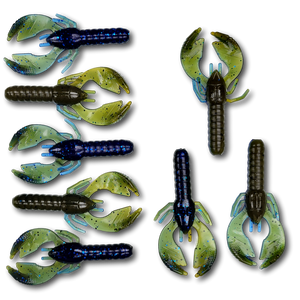Jig trailers are soft plastic or chunk-style baits designed to enhance the action, profile, and appeal of your jig. Whether you're flipping into heavy cover, swimming along grass lines, or dragging on the bottom, the trailer you choose can dramatically change how your jig performs.
The trailer’s movement, color, and size can mimic prey like crawfish, bluegill, or shad, making it easier to trigger bites from even the most finicky fish. Jig trailers aren’t just accessories—they’re essential tools for optimizing your presentation.
Choosing the right jig trailer depends on the type of jig you’re using and the fishing conditions. Here are the most popular types of jig trailers and their best applications:
- Mimic the look and movement of crawfish with lifelike claw action.
- Best used with flipping jigs, football jigs, or grass jigs.
- Perfect for dragging or hopping along the bottom in rocky or vegetated areas.
- Provide a natural swimming motion with a paddle tail.
- Ideal for swim jigs or underspin jigs.
- Effective for covering water quickly and mimicking baitfish in open water or along grass lines.
- Compact and bulky, designed for subtle movements.
- Best paired with flipping or football jigs in heavy cover.
- Great for slower presentations in cold water or when targeting finicky fish.
- Feature multiple appendages for extra movement and vibration.
- Pair well with flipping, grass, or bladed jigs.
- Effective in murky water or when fish are aggressive.
- Slim with a single or twin-tail design, offering subtle fluttering action.
- Best for finesse or swim jigs in clear water.
- Effective for both dragging and swimming presentations.
Rigging a jig trailer is simple but requires attention to detail to ensure proper action.
- Thread It Straight: When attaching the trailer, ensure it is threaded straight onto the jig’s hook. A crooked trailer can ruin the bait’s action.
- Match the Size: Choose a trailer size that complements your jig. A larger trailer adds bulk for a bigger profile, while a smaller trailer creates a more subtle presentation.
- Consider Action: Select a trailer with the right action for the situation. Craws or chunks excel for slower presentations, while swimbaits or grubs shine during active retrieves.
Fishing jig trailers depends on the type of jig:
- Flipping and Pitching: Use craw or creature trailers for heavy cover, mimicking crawfish or other prey hiding in vegetation or timber.
- Dragging: Pair football jigs with craw or chunk trailers to create lifelike scuttling action along rocky bottoms.
- Swimming: Attach a swimbait or grub trailer to swim jigs for a lifelike baitfish imitation through open water or along grass lines.
- Hopping: Use trailers with lifelike movement, like craws or creatures, to trigger reaction strikes when hopping jigs near structure or cover.
When and Where to Use Jig Trailers
Jig trailers are effective year-round but excel in specific conditions:
- Spring: Craw and chunk trailers are ideal during the pre-spawn and spawn, mimicking crawfish near shallow cover or bedding areas.
- Summer: Swimbait or creature trailers excel in deeper water or heavy vegetation, where bass are actively hunting.
- Fall: Use swimbait or grub trailers to mimic shad or baitfish as bass feed heavily in preparation for winter.
- Winter: Downsized chunk or craw trailers paired with a finesse jig can tempt lethargic bass near rocky points or deep cover.
Jig trailers are effective in lakes, reservoirs, rivers, and ponds. They’re particularly useful in areas with cover, structure, or active forage like crawfish, shad, or bluegill.
Best Colors and Sizes for Jig Trailers
Choosing the right trailer color and size depends on water clarity and forage:
- Clear Water: Natural colors like green pumpkin, watermelon, and brown mimic crawfish or baitfish effectively.
- Stained or Murky Water: Bright or high-contrast colors like black and blue, chartreuse, or orange improve visibility.
- Low-Light Conditions: Use darker colors like black or junebug to create a strong silhouette.
Trailer size should complement your jig:
- Smaller trailers (2–3 inches) are perfect for finesse presentations or targeting finicky fish.
- Larger trailers (4–6 inches) add bulk and action, ideal for aggressive fish or murky water.
Why Jig Trailers Are So Effective
Jig trailers bring versatility and customization to your jig fishing game. They add lifelike action, adjust the jig’s profile, and help mimic local forage, making your presentation more appealing to fish.
The right trailer can enhance the jig’s effectiveness, whether you’re flipping into heavy cover, swimming through grass lines, or dragging along rocky bottoms. Their adaptability makes jig trailers an essential component of any angler’s arsenal.
Tips for Using Jig Trailers
- Experiment with Pairings: Mix and match jigs and trailers to find the perfect combination for the conditions.
- Match the Hatch: Choose colors and shapes that mimic the prey in your area.
- Adjust for Conditions: Use subtle-action trailers in cold water or clear conditions, and more aggressive trailers in warm water or murky conditions.
- Rig Correctly: Ensure the trailer is threaded straight and securely onto the hook for optimal action.
Jig trailers are more than an accessory—they’re a key part of creating an effective presentation. Their ability to add action, bulk, and realism to your jigs makes them indispensable for anglers targeting bass and other predatory fish. Whether you’re flipping, dragging, or swimming your jigs, the right trailer can make all the difference. Stock up on your favorite styles, colors, and sizes, and let jig trailers elevate your fishing game.
Qwik Catches!



























